What: Layne Kennedy: The Art of the iPhone
Where: Mpls Photo Center, 2400 N. Second St.
When: Now through Feb. 26
Cost: Free
The wide availability of smartphones has brought increasingly higher quality cameras to the masses and allowed people to take pictures more spontaneously and edit them on the fly. What does this mean for professional photographers? Does the rise of the eight-megapixel iPhone and Instagram marginalize their craft? Or can a photographer explore the new possibilities these tools provide?
Local editorial photographer Layne Kennedy explores the latter path in The Art of the iPhone, a new exhibit at the Mpls Photo Center.
âÄúFor me it is a reminder of the spiritual and instinctive nature of photography. No over-thinking, no grabbing the perfect lens, no waiting for the ideal time of day. ItâÄôs my gut that drives my vision,âÄù Kennedy wrote in the exhibitâÄôs artist statement.
These photos were not simply taken on the iPhone, they are of the iPhone, and distinct from a photo taken with professional photography equipment. The spontaneity and the instant gratification define the work.
âÄúThe iPhone is not a camera; itâÄôs a device. I think people understand the limitations,âÄù said Orin Rutchick, founder and Executive Director of Mpls Photo Center.
The 48 photos being shown were edited using an iOS application called Hipstamatic, which, similar to Instagram, allows the user to run his or her pictures through a number of filters and effects quickly.
Some would point to Hipstamatic and similar apps as lazy or hacky, but Rutchick believes that their use is a defining aspect of iPhone photography as a separate genre.
âÄúIn this case [Kennedy] doesnâÄôt want to compromise the work he does for his business. This is a different animal. HeâÄôs trying to make a clear delineation between his regular work and the work he does with the iPhone,âÄù Rutchick said.
Additionally, Rutchick believes that these pieces still stand up to scrutiny as works of art.
âÄúI think the skill is more in the composition. Regardless of what the app did, the photo would still be able stand on its own,âÄù he said.
The Mpls Photo CenterâÄôs interest in iPhone photography goes beyond this exhibit. The Photo Center holds many photography classes, including several on iPhone photography.
The Photo Center is also using iPhone photography for its display during the next Northern Spark Festival. Kennedy and the Star TribuneâÄòs Richard Sennott, another Mpls Photo Center instructor and iPhone enthusiast, will take groups on walking tours around Minneapolis armed only with iPhones. The pictures that the groups take will be displayed on a 30-by-30 foot screen, playing with the iPhoneâÄôs instant gratification on a larger scale.
âÄúIn the âÄô50s Kodak introduced the Brownie camera, and that revolutionized photography, democratized it. The digital camera has done the same thing.âÄù Rutchick said.
While the iPhone may not have the same impact on photography as the Brownie or the digital camera, it has certainly put more photography into more hands faster, and thatâÄôs something worth exploring.














